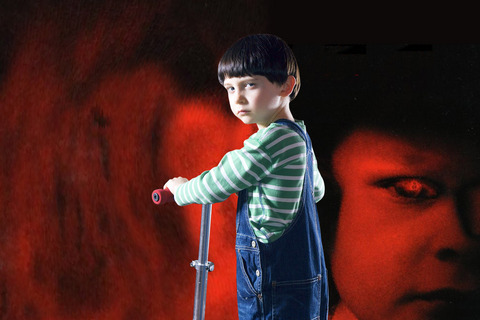When all else fails, pump up the thunder and lightning. That seems to be an operating principle behind the supremely unnecessary remake of The Omen, the 1976 horror fest that, along with Rosemary's Baby and The Exorcist, plunked everyone's favorite baddie, Satan, into the Hollywood mainstream.
The incessant rumbling and flashing that accompanies virtually every other scene underscores the hollowness of a story that in the decades since the original Omen has had any freshness trampled out of it by a rampaging army of Freddies, Jasons and Michael Myerses, not to mention assorted Omen and Exorcist sequels and knockoffs.
Another strategy is to empty the dog pound. To go with the thunder and lightning, the movie deploys a veritable kennel of snarling black Rottweilers bounding out of the bowels of hell to announce the presence of Beelzebub.

Yet I suppose an Omen redux makes sense as a crass gamble in an age of tabloid theology and as a product shrewdly timed to ride on the coattails of The Da Vinci Code. Its epigraph reads: "From the Eternal Sea he rises/Creating armies on either side/Turning man against his brother/'Til man exists no more." That's what I call Revelation for Dummies.
Early in the movie a shot of the World Trade Center in flames, introduced as a portent of Armageddon, sharpens this remake's sour tang of exploitation. Aside from such touches (there's also a Hurricane Katrina devastation shot), the new Omen, whose screenwriter, David Seltzer, wrote the original, slavishly recycles itself.
As before, respectable actors stoop to lend a spurious gravitas to all the muttering and scowling. Assuming the Gregory Peck role of Robert Thorn, the American ambassador to Britain who refuses to believe his wife's hysterical insistence that their demonic little boy, Damien, is the ultimate bad seed, Liev Schreiber labors successfully to keep a straight face. In the Lee Remick role of Robert's wife, Katherine, Julia Stiles has taken another wasteful misstep in her largely mismanaged career; too intelligent and talented for this sort of rubbish, she should be following the same high road as Maggie Gyllenhaal.

PHOTOS: COURTESY OF BVI
The casting of Mia Farrow (the mother of Rosemary's Baby) as Mrs. Baylock, the nanny from hell, lends The Omen a twist of gallows humor. Every spoonful of sugar dispensed by this apple-cheeked, sweeter-than-saccharine Mary Poppins is laced with arsenic.
Jennings (David Thewlis), the paparazzi snoop whose pictures offer clues to the supernatural shenanigans, is appropriately disheveled. And Pete Postle-thwaite and Michael Gambon squander their talents as nostril-flaring loons who know too much for their own good.
Directed by John Moore (Behind Enemy Lines, Flight of the Phoenix), The Omen is terminally glum and waterlogged (from the downpours with the thunder and lightning). The only smiles to be seen are the faint traces of a smirk on Farrow's lips as her character carries out the Devil's work.
The movie's little jolts are effective for being so sparingly interjected. In the most unsettling scene, Damien's visit to a zoo riles up the animals; a gorilla tries to break out of its cage, and screaming children scatter in panic.
The most kinetic sequence is Robert's last mad dash to a church, clutching his screaming boy. A church is the only place where the little demon can be returned to hell. "Get Me to the Church on Time" doesn't begin to describe the horrors that will ensue if he's a split second behind schedule.

May 26 to June 1 When the Qing Dynasty first took control over many parts of Taiwan in 1684, it roughly continued the Kingdom of Tungning’s administrative borders (see below), setting up one prefecture and three counties. The actual area of control covered today’s Chiayi, Tainan and Kaohsiung. The administrative center was in Taiwan Prefecture, in today’s Tainan. But as Han settlement expanded and due to rebellions and other international incidents, the administrative units became more complex. By the time Taiwan became a province of the Qing in 1887, there were three prefectures, eleven counties, three subprefectures and one directly-administered prefecture, with

Taiwan Power Co (Taipower, 台電) and the New Taipei City Government in May last year agreed to allow the activation of a spent fuel storage facility for the Jinshan Nuclear Power Plant in Shihmen District (石門). The deal ended eleven years of legal wrangling. According to the Taipower announcement, the city government engaged in repeated delays, failing to approve water and soil conservation plans. Taipower said at the time that plans for another dry storage facility for the Guosheng Nuclear Power Plant in New Taipei City’s Wanli District (萬里) remained stuck in legal limbo. Later that year an agreement was reached

What does the Taiwan People’s Party (TPP) in the Huang Kuo-chang (黃國昌) era stand for? What sets it apart from their allies, the Chinese Nationalist Party (KMT)? With some shifts in tone and emphasis, the KMT’s stances have not changed significantly since the late 2000s and the era of former president Ma Ying-jeou (馬英九). The Democratic Progressive Party’s (DPP) current platform formed in the mid-2010s under the guidance of Tsai Ing-wen (蔡英文), and current President William Lai (賴清德) campaigned on continuity. Though their ideological stances may be a bit stale, they have the advantage of being broadly understood by the voters.

In a high-rise office building in Taipei’s government district, the primary agency for maintaining links to Thailand’s 108 Yunnan villages — which are home to a population of around 200,000 descendants of the Chinese Nationalist Party (KMT) armies stranded in Thailand following the Chinese Civil War — is the Overseas Community Affairs Council (OCAC). Established in China in 1926, the OCAC was born of a mandate to support Chinese education, culture and economic development in far flung Chinese diaspora communities, which, especially in southeast Asia, had underwritten the military insurgencies against the Qing Dynasty that led to the founding of